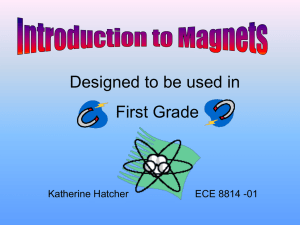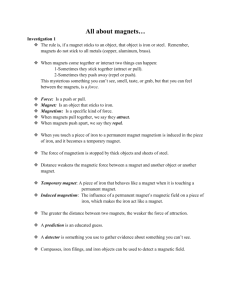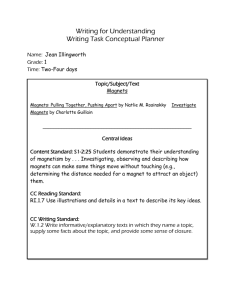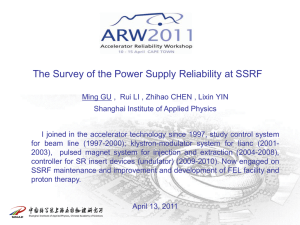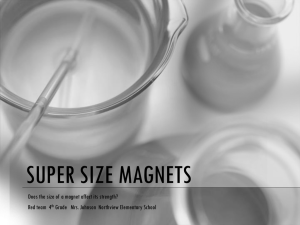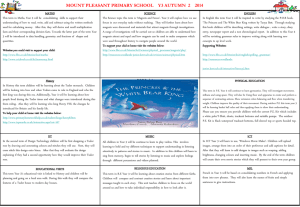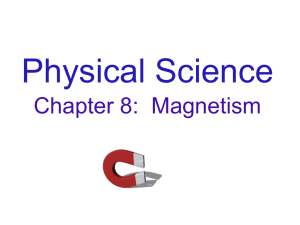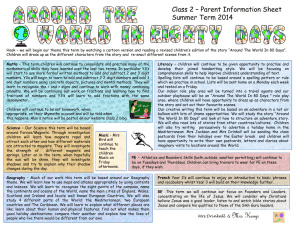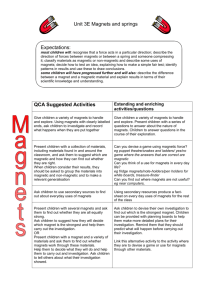1st Grade Science: Sorting Properties & States of Matter
advertisement
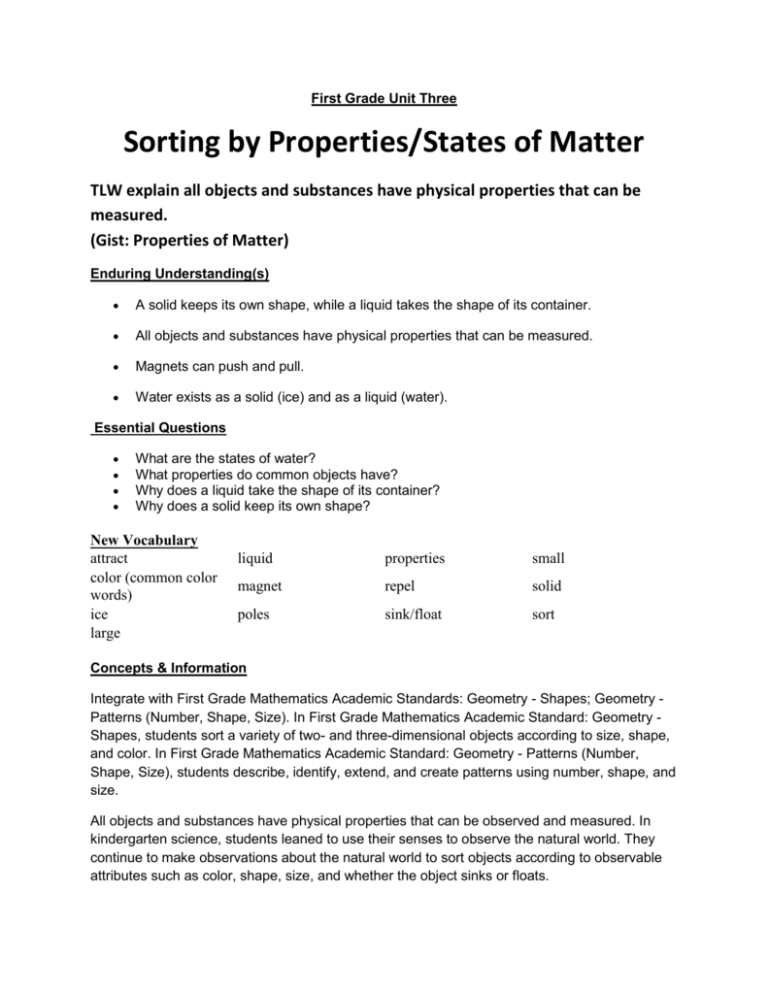
First Grade Unit Three Sorting by Properties/States of Matter TLW explain all objects and substances have physical properties that can be measured. (Gist: Properties of Matter) Enduring Understanding(s) A solid keeps its own shape, while a liquid takes the shape of its container. All objects and substances have physical properties that can be measured. Magnets can push and pull. Water exists as a solid (ice) and as a liquid (water). Essential Questions What are the states of water? What properties do common objects have? Why does a liquid take the shape of its container? Why does a solid keep its own shape? New Vocabulary attract color (common color words) ice large liquid properties small magnet repel solid poles sink/float sort Concepts & Information Integrate with First Grade Mathematics Academic Standards: Geometry - Shapes; Geometry Patterns (Number, Shape, Size). In First Grade Mathematics Academic Standard: Geometry Shapes, students sort a variety of two- and three-dimensional objects according to size, shape, and color. In First Grade Mathematics Academic Standard: Geometry - Patterns (Number, Shape, Size), students describe, identify, extend, and create patterns using number, shape, and size. All objects and substances have physical properties that can be observed and measured. In kindergarten science, students leaned to use their senses to observe the natural world. They continue to make observations about the natural world to sort objects according to observable attributes such as color, shape, size, and whether the object sinks or floats. Observable attributes and properties of objects that an elementary scientist should know are: Buoyancy – sink or float Weight – heavy or light, heavier or lighter Smell – unpleasant, unpleasant, fresh, pungent, smoky, burnt, moldy, putrid, fragrant, sweet Texture – rough or smooth Flexibility – rigid, stiff, firm or flexible Shape – circle, square, rectangle, triangle, oval Size – large or small Color – common colors Magnetic properties – attract-pull, repel-push The mastery of these attributes is important to a scientist’s ability to classify and organize. This classification helps them understand the world around them. Whether an object will sink or float in water depends on several factors, all too complicated for first graders! For teacher information, an object will float if its density (mass ÷ volume) is less than the density of water (which is equal to 1). Density in nonscientific terms is mass divided by the space the object takes up (volume). A huge super tanker weighs a lot but it takes up even more space, so its density is less than the density of water. The ship displaces an amount of water equal to its weight; therefore it can float. Common substances include: solids (metal, wood, plastic and styrofoam); liquids (water, alcohol, milk, juice and gasoline); and gases (air, helium and water vapor). Magnetism is a force that causes certain materials to attract each other and is a physical property that can be observed. Ends of magnets are referred to as "north or south poles." Round magnets are referred to as "front and back." Poles are either south-seeking or northseeking. Like poles repel; opposite poles attract. Metal objects containing iron, nickel, steel and cobalt are attracted by magnets. Metals such as brass, copper and aluminum are nonmagnetic. A lodestone is a natural magnet. Each magnet possesses a force which allows it to attract metal. The metal object does not possess magnetic force. Sorting objects using magnets is used in factories and industry. Food packaging companies use large magnets to remove any iron debris from machinery that may have contaminated food, such as cereals and grains. Magnets are also used to sort and transport objects in a junkyard and at the recycling center. At this age students are engaged in a high interest activity that will lay a foundation for exploration, questioning, and interaction with peers. Materials can be useful if they are waterproof, lightweight, conduct electricity, are attracted to a magnet, conduct heat, float, or have other characteristics which have practical applications. Lesson Ideas: 1. TLW collaboratively determine the meaning of observable attributes through roleplay.CCSS/CE(s): P.PM.01.11; Have a small group of students go to the front of the room, one group at a time. Give oral directions to each group. The group silently gets into the correct order. Group 1 – Order tallest to shortest in height. Group 2 – Order longest hair to shortest hair. Group 3 – Order longest feet to shortest feet. Group 4 – Order longest arms to shortest arms. Note: This activity starts with what students have learned from First Grade Science Academic Standard: Science Processes - Tools of the Scientist and extends the learning to other attributes, because role-play activities can be created for other comparisons including color, shape, size, and sinking/floating. Include soft/hard, light/heavy, sink/float, etc. 2. TLW investigate various properties of common objects.CCSS/CE(s): P.PM.01.11; P.PM.01.31; P.PM.01.32; S.IA.01.12; S.IA.01.13; S.IA.01.14; S.IP.01.11; S.IP.01.12; S.IP.01.13; S.IP.01.14; (Resource: What Shapes Are My Blocks; Properties of Objects; Hard or Soft; Flexible or Firm; Rough or Smooth; Sink or Float; Heavy or Light) Use a hand lens to observe objects. Students can review other observable properties studied in Kindergarten Science (Kindergarten Science Academic Standard: Science Processes - Senses): texture, smell, and flexibility. Then move to Resource: What Shapes Are My Blocks where students identify shapes, which should be familiar from their study of First Grade Mathematics Academic Standard: Geometry Shapes. In activities for this lesson, sort using real objects where available rather than pictures of the objects. Common objects include things such as desks, coins, pencils, feathers, rocks, etc. Investigate specific properties using learning stations with Resources: Hard or Soft; Flexible or Firm; Rough or Smooth; Sink or Float; Heavy or Light; The Force is With You. Resources: What Shapes Are My Blocks; Properties of Objects; and Hard or Soft may be used as embedded assessments. 3. TLW identify materials that are attracted by magnets. CCSS/CE(s): P.PM.01.31; S.IA.01.12; S.IA.01.13; S.IA.01.14; S.IP.01.11; S.IP.01.12; S.IP.01.13; S.RS.01.11; (Resource: The Force is With You; Magnetic or Non-Magnetic) Students will use trial and error to determine what materials are attracted to a magnet and demonstrate how to position a magnet to make it push and how to make it pull. 4. TLW observe that like poles of a magnet repel and unlike poles of a magnet attract.CCSS/CE(s): P.PM.01.32; For the property of magnetism, students need to know that like poles repel; opposite poles attract. Students in first grade do not need to know the names of the poles. Use 2 magnets to observe how some ends together make a pull and some make a push. Students will play with bar, disk, and horseshoe magnets and feel pushes and pulls. 5. Given teacher-selected objects, TLW collaboratively identify properties of the objects which make them useful in everyday life.CCSS/CE(s): (Resource: Usefulness of Objects) Waterproof raincoat, cotton or wool for clothing, glass for windows, metal pan to conduct heat for cooking, magnets for refrigerators, etc. 6. TLW demonstrate that water as a solid keeps its own shape and that water as a liquid takes the shape of various containers. CCSS/CE(s): P.PM.01.21; P.PM.01.22; S.RS.01.11; Include the physical property of states of matter (solid and liquid), with students being able to demonstrate that water as a solid keeps its own shape (ice) and that water as a liquid takes on the shape of various containers. Put an ice cube in a container and move it around. Students will be able to observe that the ice cube maintains its shape (until it melts and becomes water, at which time, as a liquid, it will take on the shape of its container.) Observe ice cubes, have students hold in hand to see melting. Use thermometers to take temperature of water. Students pour water to container to see it flow. Discuss other liquids in their lives. Suggested Instructional Resources Mostly Magnets, AIMS, "What will a Magnet Attract", p. 7; "Hungry Hounds," p. 57; "Floating Magnets," p. 61 Branley, Franklyn Mansfield. (1996). What Makes a Magnet? (Let’s Read and Find Out Science). New York: HarperTrophy. Fowler, Allan. (1995). What Magnets Can Do. Chicago: Children’s Press. Livingston, James D. (1997). Driving Force: The Natural Magic of Magnets. Boston: Harvard Press. Mole, Karen Bryant. (1998). Magnets (Science All Around Me). New York: Heineman. Zoehfeld, Kathleen Weidner. (1998). What is the World Made Of? New York: HarperCollins.

